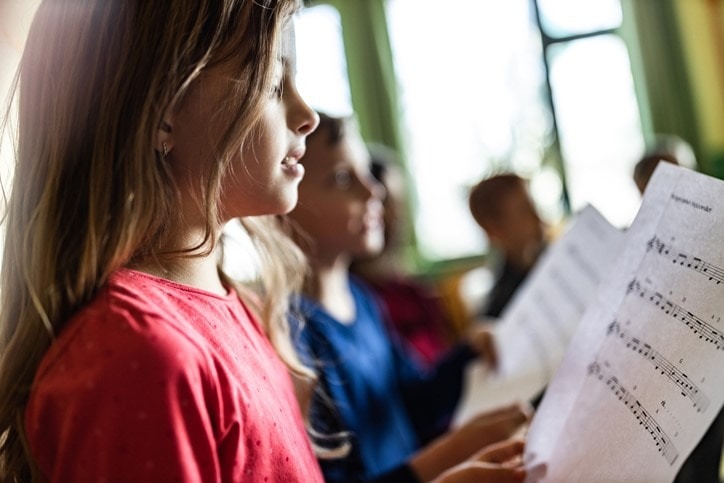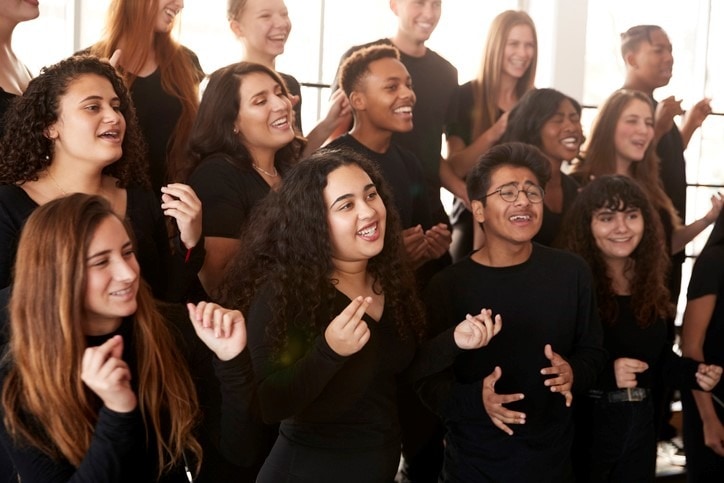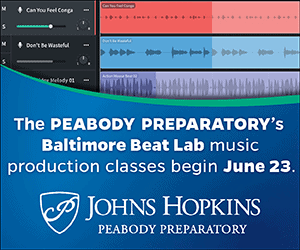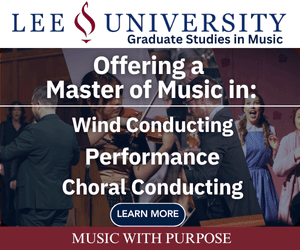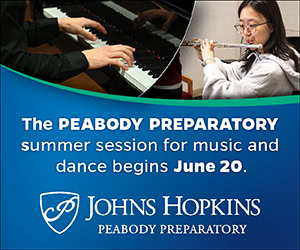/ News Posts / Creating, Responding, and Connecting in the Ensemble
Creating, Responding, and Connecting in the Ensemble
Ideas for Inclusion
By NAfME Member Daniel Albert
Daniel Albert presented on “Creating, Responding, and Connecting in the Ensemble” during the NAfME 2021 PreK–12 Learning Collaborative in February 2021.
You might agree or disagree with the premise of national standards and, in the case of music education, the National Core Arts Standards. However, they do remind us of what a comprehensive music education includes: Creating, Performing, Responding, and Connecting. Few would disagree about the importance of including these activities in a music classroom. At the same time, many of our colleagues think the following:
- “I’m not comfortable with (fill in with a creative musicianship activity) myself and don’t feel comfortable teaching it to my students.”
- “I barely see my students. Why should I do these activities with them?”
Why Create, Respond, and Connect in the Ensemble?
Music education researchers have studied how inclusion has benefitted students. Engaging in creative musical processes, as well as connecting to other arts and subject areas, improves students’ musical understanding and increases their interest in music.1 For those of us who teach music primarily through ensemble-based means, developing multiple facets of musicianship, such as improvisation and learning by ear, as well as analyzing music, enhance performance.2 Think of including creating, responding, and connecting not as time-consuming “add-ons,” but additional palettes or choices with which to work.
I’ll share some ideas with you on how to include these activities in the ensemble classroom based on my own experiences as a middle school music educator who taught largely through the ensemble paradigm. However, one can adapt these ideas easily for other grade levels, and they are just the tip of the iceberg. You and your students’ imaginations can take learning through these means to some very cool and fun places!
Know Your Score!
Remember this from your conducting classes? Ensemble teachers need to be intimately familiar with the works they use to teach musical concepts. Knowledge of the score and how those concepts are translated through the music will help music educators brainstorm possibilities for ensemble activities that incorporate creating, responding, and connecting.
Review the National Core Arts Standards
Rather than being prescriptive, the National Core Arts Standards are meant to provide educators with flexibility in providing activities that encourage multiple means of engaging with the arts and connecting to other subject areas. Parameters for each Anchor Standard are quite broad, providing music educators and their students with ample opportunities for interesting and varied educational opportunities within the ensemble setting.
Possible Activities
Here are some activities that I have undertaken that are in the spirit of the Standards. Again, consider these as “jumping-off points” for your own classroom.
Creating via Learning by Ear
Instrumental music educators know that having students sing in rehearsals builds their musicianship and performance skills in multiple ways. Regardless of the ensemble medium, consider the following learning-by-ear activities in tandem with singing and, if applicable, performing on instruments:
- Employ call-and-response games between teacher and a student, as well as students with each other, then “trade 2s and 4s.”
- Use solfege in rehearsals to connect sound with visual representation.
- Teach scales, as well as prominent and recurring melodies by ear.
- Sing warm-up exercises, chorales, arpeggios, rhythms, and pitch sequences.
The more you do these activities, the better and easier they will get! Then, as students gain experience with learning music strictly through aural means, students can organize themselves into small groups and arrange popular songs for themselves or the ensemble, as well as compose for solo or small ensemble. Providing space during concerts to showcase students’ efforts is such a powerful way to affirm their work and musical identities.
Creating and Connecting
For programmatic works, find a photograph or work of art that is related to the musical work you are studying.
- Analyze the picture in a small group and/or class discussion: what is taking place?
- Through that discussion, situate the work of art and musical work within a societal, cultural, and historical context to deepen students’ understanding.
- Students then break off into small groups to compose a short musical work depicting the scene. Another option would be to create an ensemble composition.
- Have students describe how musical elements were manipulated to depict the scene.
Responding and Connecting
- Students keep a reflective log as they rehearse a musical work, then create a story based on their log entries. Students then can compose a musical work based on that story, addressing how they use elements of music that evoke the actions that take place within it.
- Vocal music educators know that text is an integral part of a choral work. Discussions of the text with students should include applicable artistic and historical connections, meaning, and underlying message, how it complements the music and can influence the listener, and any special effects derived from the text.
Take Small Steps
If you are just embarking on implementing creating, responding, and connecting activities in your ensemble, remember that not everything you devise will go to plan or be as effective as you hoped. Seize the opportunity for “teachable moments.” And, as any good educator would do, reflect on what went well and how you would refine the activity for the future.
Have fun! You’ll be learning along with your students, which is quite exciting and can lead to places you hadn’t thought possible!
Notes
[1] Michele Kaschub and Janice Smith, Minds on Music: Composition for Creative and Critical Thinking (Lanham, MD: Rowman and Littlefield, 2009); Michele Kaschub and Janice Smith, Experiencing Music Composition in Grades 3-5 (New York: Oxford University Press, 2017); Elizabeth A, Menard, “Music Composition in the High School Curriculum: A Multiple Case Study,” Journal of Research in Music Education 63, no. 1 (2015): 114-136; Corin T. Overland, “Integrated Arts Teaching: What Does It Mean for Music Education?” Music Educators Journal 100, no. 2 (2013): 31-37.
[2] James R. Austin, “Comprehensive Musicianship Research: Implications for Addressing the National Standards in Music Ensemble Classes,” Update: Applications of Research in Music Education 17, no. 1 (1998), 25-32; Gary E. McPherson, “Cognitive Strategies and Skill Acquisition in Musical Performance,” Bulletin of the Council for Research in Music Education 133 (1997), 64-71.
Suggested Resources
Ann C. Clements, ed., Alternative Approaches in Music Education: Case Studies from the Field (Lanham, MD: Rowman & Littlefield, 2013).
Patrick K. Freer, “Choral Improvisation: Tensions and Resolutions,” Choral Journal 51, no. 5, (2010): 18-31.
Lucy Green, Music, Informal Learning, and the School: A New Classroom Pedagogy (Burlington, VT: Ashgate Publishing, 2008).
Maud Hickey, Music Outside the Lines: Ideas for Composing in K-12 Music Classrooms (New York: Oxford University Press, 2012).
Michele Kaschub and Janice Smith, Minds on Music: Composition for Creative and Critical Thinking (Lanham, MD: Rowman and Littlefield, 2009).
Michele Kaschub and Janice Smith, Experiencing Music Composition in Grades 3-5 (New York: Oxford University Press, 2017).
Jody Kerchner and Katherine Strand, eds., Musicianship: Composing in Choir (Chicago: GIA Publications, 2016).
Clint Randles and David Andrew Stringham, eds., Musicianship: Composing in Band and Orchestra (Chicago: GIA Publications, 2013).
Laura K. Sindberg, Just Good Teaching: Comprehensive Musicianship through Performance (CMP) in Theory and Practice (Lanham, MD: Rowman and Littlefield, 2012).
Jackie Wiggins, Teaching for Musical Understanding, 3rd edition (New York: Oxford University Press, 2015).
Robert H. Woody, “Playing by Ear: Foundation or Frill?” Music Educators Journal 99, no. 2, (2012): 82-88.
About the author:
 Daniel Albert is Assistant Professor of Music Education at the University of Massachusetts Amherst. He received his Bachelor of Music degree, summa cum laude, from the University of Massachusetts Amherst, his Master of Music (Music Education) degree from the University of Michigan, and his Doctor of Philosophy in Music Education degree from Michigan State University.
Daniel Albert is Assistant Professor of Music Education at the University of Massachusetts Amherst. He received his Bachelor of Music degree, summa cum laude, from the University of Massachusetts Amherst, his Master of Music (Music Education) degree from the University of Michigan, and his Doctor of Philosophy in Music Education degree from Michigan State University.
Albert was previously Assistant Professor of Music, Human Development, and Learning at Augsburg University in Minneapolis. Prior to graduate studies, Albert taught classroom general music and instrumental music for 11 years at Glenbrook and Williams Middle Schools in Longmeadow, Massachusetts. Additionally, Daniel was Chairperson, Immediate Past Chairperson, and Treasurer of the Western District of the Massachusetts Music Educators Association, Western District Representative to the Massachusetts Instrumental and Choral Conductors Association’s Executive Board, and a member of the Massachusetts Department of Elementary and Secondary Education’s Arts Education Advisory Council.
Albert has presented research papers and posters at national and international conferences, and he has authored and co-authored research papers and articles in the Journal of Research in Music Education, Journal of Music Teacher Education, Arts Education Policy Review, Research Studies in Music Education, Music Educators Journal, Contributions to Music Education, Update: Applications of Research in Music Education, The Instrumentalist, Michigan Music Educator, and the Massachusetts Music News. As part of his service to the profession, Albert is serving a four-year term as a member of the Editorial Committee of Music Educators Journal.
Read Daniel Albert’s full biography here.
Did this blog spur new ideas for your music program? Share them on Amplify! Interested in reprinting this article? Please review the reprint guidelines.
The National Association for Music Education (NAfME) provides a number of forums for the sharing of information and opinion, including blogs and postings on our website, articles and columns in our magazines and journals, and postings to our Amplify member portal. Unless specifically noted, the views expressed in these media do not necessarily represent the policy or views of the Association, its officers, or its employees.
June 29, 2021. © National Association for Music Education (NAfME.org)
Published Date
June 29, 2021
Category
- Ensembles
- Standards
Copyright
June 29, 2021. © National Association for Music Education (NAfME.org)
